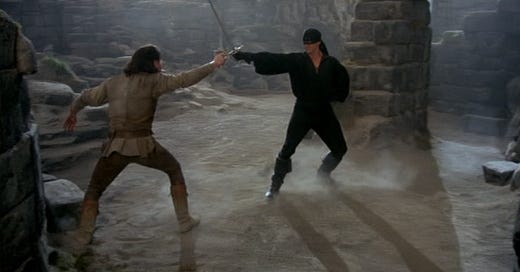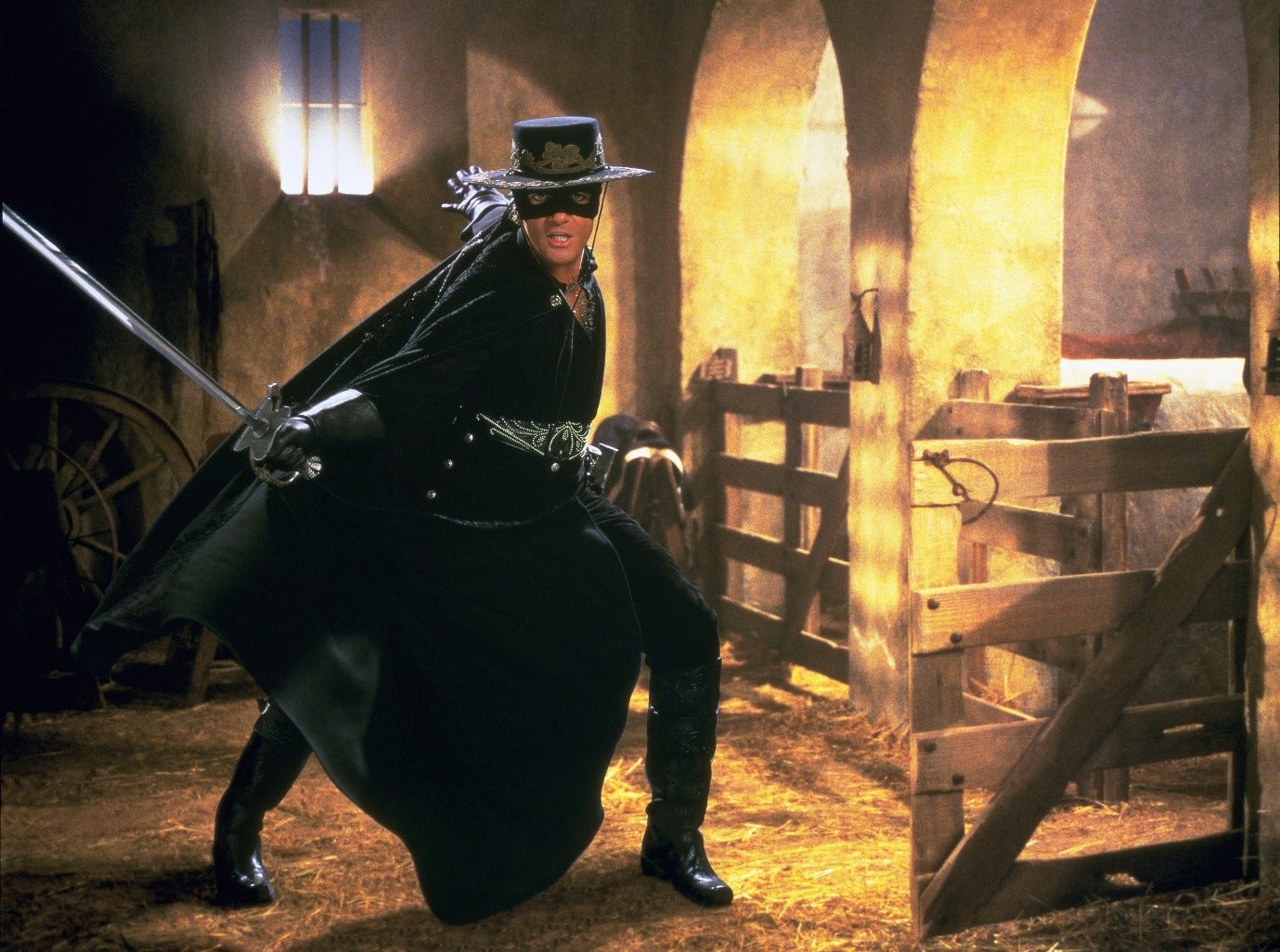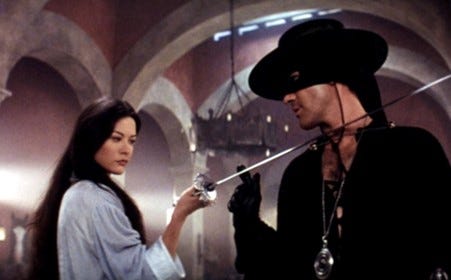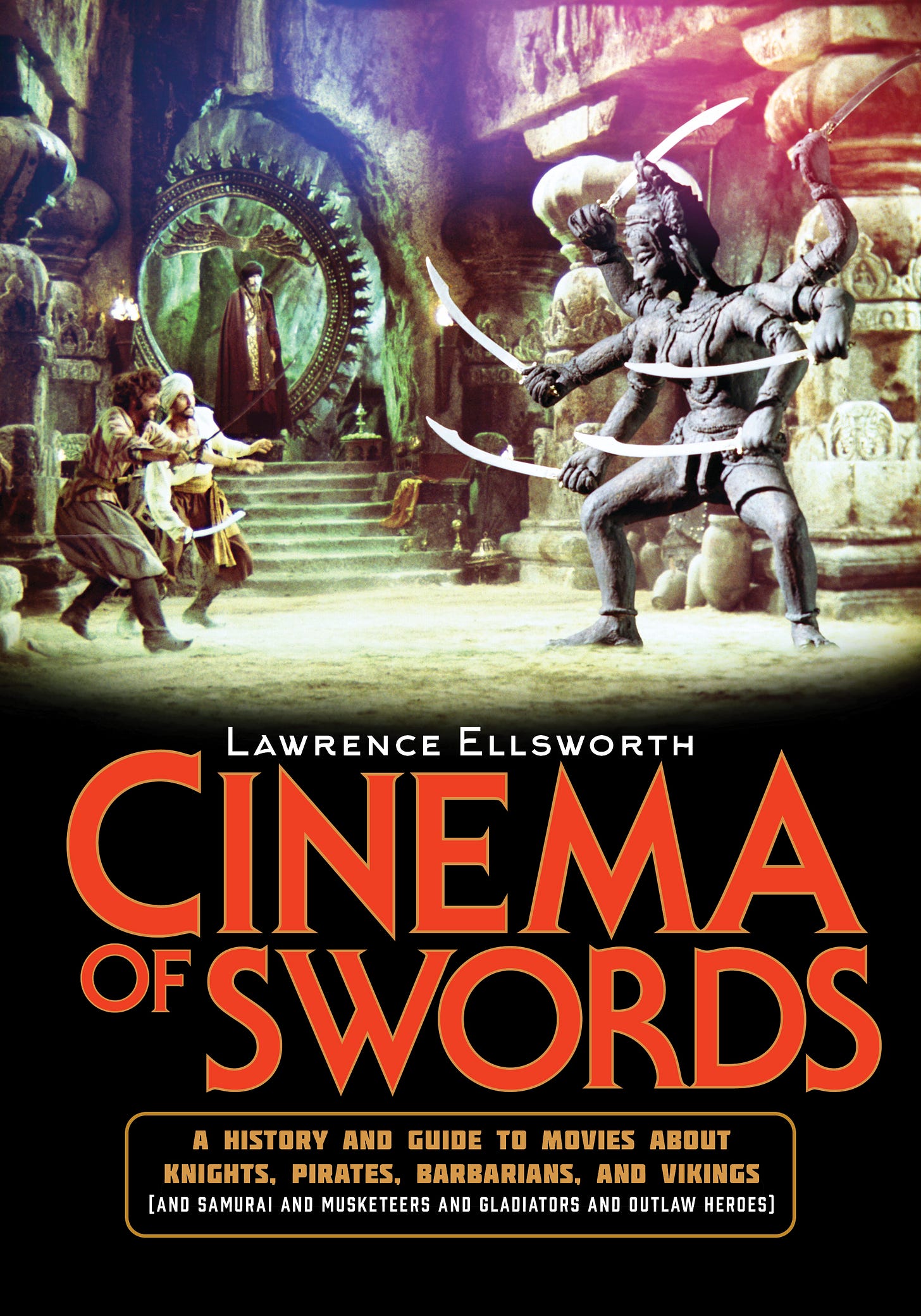Cinema of Swords
A Popular Guide to Movies about Knights, Pirates, Samurai, and Vikings (And Barbarians, Musketeers, Gladiators, and Outlaw Heroes)
By Lawrence Ellsworth
Welcome to the Cinema of Swords Substack! This series is a companion and expansion to the Cinema of Swords hardcover (Applause Books, 2023), which collects over 400 tasty mini-reviews of screen swashbucklers from the Silent Era through The Princess Bride.
This Substack builds on that foundation, continuing forward with reviews of swordplay movies and TV shows from the ‘90s to the present. Every week I’ll present two to four illustrated reviews on a common theme written both to inform and to entertain.
If you enjoyed the contents of the book, this weekly series will give you plenty more of the same. (And if you haven’t seen the book, look for it wherever you do your book shopping!)
Swashbuckler Outlaws
After several weeks covering less-than-top-notch films, it’s a pleasure to bring you two five-star winners this time around, and they’re classic swashbucklers into the bargain! As far as the late ‘90s go, these are as good as it gets, and if you haven’t seen one or both of them, well, there’s your evening or weekend sorted.
One thing these two near-classics bring to mind is the close association between swashbuckling and outlawry. A swashbuckler, in any of the many demi-genres we cover, nearly always lives by his own personal code of behavior, and if their behavior clashes with the expectations of law and society, they’re just doing what they regard as the right thing. In fact, it’s the clash between the social and the personal that is so often the key theme of a swashbuckler’s story—as exemplified by the films that follow.
On Guard (or Le Bossu)
Rating: *****
Origin: France/Italy, 1997
Director: Philippe de Broca
Source: Pathé DVD
Paul Féval, père (1816-1887) was one of the greatest genre fiction authors of 19th-century France, writing detective stories before Doyle and vampire stories before Stoker, but perhaps his most popular and enduring novel is Le Bossu, or The Hunchback (1857), a swashbuckler nearly as beloved as Dumas’ Three Musketeers or Count of Monte Cristo. It’s been brought to the screen a half dozen times in France, but never more effectively than this adaptation.
On Guard is superb; its first 45 minutes are near-perfect, encapsulating everything you want from a swashbuckling film. The rest of the movie is fine as well, just not as tightly paced as its first act, since it must cover a period of years as one of the main characters matures to an adult. As is traditional with old-school cape-and-sword melodramas, this is one plot-heavy beast, but I’ll try to sketch in the outlines to convey its classic elements. In Paris in 1700, Lagardère (Daniel Auteuil), a charming and talented young sellsword of no birth or breeding, has managed to attach himself to the noble household of the Duke of Nevers (Vincent Pérez). When Nevers learns that his lover Blanche de Caylus (Claire Nebout) has borne him a child in her remote mountain domain, he sets off to marry her and adopt the babe—but as this would make Nevers’ jealous younger brother Gonzague (Fabrice Luchini) no longer Nevers’ heir, Gonzague decides that both his brother and his child must die. An assassination attempt in Paris by a team of five shows how brilliant a swordsman Nevers is when he kills them all, and with the threat now apparent, he engages Lagardère to accompany him as his bodyguard.
There are several other attempts to kill Nevers on the journey, so the duke teaches Lagardère his secret sword attack (a staple of the genre), a deadly combination called the Nevers Thrust that ends with a lethal stab between the opponent’s eyes. The pair reach Caylus and Nevers marries Blanche, but then Gonzague and his killers arrive and slay the entire wedding party. However, after wounding Gonzague on the hand (“So I’ll know you again”), Lagardère escapes with the baby, Aurore de Nevers, and the pair hide among a troupe of traveling entertainers.
The above is the near-perfect part. Then the movie slows as Lagardère raises Aurore (Marie Gillain) among the acting troupe as his own daughter, teaching her what skills he can, including the Nevers Thrust, without revealing her true background. But in Paris again, when Aurore is seventeen, Gonzague accidentally learns that his niece (and true heir to his fortune) is still alive, so he unleashes his assassins to kill her and Lagardère. The latter hides Aurore among Paris’ criminal class, and then intrigues to regain his foster daughter her inheritance, assuming the guise of a wily hunchback who gradually leads Gonzague into a trap that will expose his villainy.
And this brings us to the creepy bit that’s tough for a modern audience to face, wherein Aurore, after learning that Lagardère isn’t actually her father, reveals that she loves him romantically and wants to be his wife despite their age difference and, er, former relationship. Ew. But if you can get past that, On Guard is a must-watch: the performances are all great, the direction is nearly flawless, the swordplay is exciting and persuasive, the scenery is magnificent, the costumes and sets are splendid, and the musical score is jaunty and period-appropriate. And its signature line, “If you don’t come for Lagardère, Lagardère will come for you,” is nearly as well known in France as, “All for one and one for all.” Classic stuff.
The Mask of Zorro
Rating: *****
Origin: USA, 1998
Director: Martin Campbell
Source: TriStar DVD
This is a top-notch swashbuckler, very nearly a must-watch. It’s a sequel of sorts to the usual Zorro story, a passing of the hero’s mask to a new generation. It’s also a Stephen Spielberg production, and that director’s signature overwrought bloat nearly sinks the ending.
But the beginning is sublime. The ten-minute sequence of the original Zorro’s final exploit, saving three unjustly condemned men from the scaffold during Mexico’s revolution against Spain in 1821, perfectly captures what makes the dashing black-clad hero of the people so appealing, while sowing the seeds of the story to follow. As Zorro thwarts his nemesis, Don Rafael Montero (Stuart Wilson), the Governor of California, his swordplay and acrobatics are watched with worshipful eyes by two young peasant brothers, Joaquin and Alejandro. But the sequel to this triumph is tragedy, as Montero, having deduced Zorro’s secret identity as Diego de La Vega (Anthony Hopkins), brings troops to Diego’s mansion to arrest him—and in the course of the arrest Diego’s wife is killed. As Diego is dragged off to prison, Montero, who had desired Diego’s wife, abducts his infant daughter Elena to raise as his own.
Cut to twenty years later: the young brothers, Alejandro and Joaquin Murrieta (the latter based on a legendary Gold Rush-era outlaw hero), are bandits in Upper California. When Joaquin is killed by the (quasi-historical) Texan cavalry officer Harrison Love (Matt Letscher), Alejandro (Antonio Banderas) swears to avenge him. Meanwhile, Montero returns from Spain with big plans, so the aging Diego escapes from prison to enact his own revenge—which he aborts when he sees that Montero has brought his now-adult daughter Elena with him (Catherine Zeta-Jones, radiant). Diego encounters the furious but ineffectual Alejandro, sees his potential, and takes him on as his protégé, promising to train him to complete his vengeance on Montero’s aide, Captain Love—and enact Zorro’s own revenge in the process.
That setup concludes the first hour of the film, and the second hour is nearly all well-paced action and intrigue, as the new Zorro trains in both fencing and courtly etiquette, while conducting a burgeoning romance with the hot-blooded Elena. The brooding Banderas and smoldering Zeta-Jones have real onscreen chemistry, dancing and fencing with both words and blades. Anthony Hopkins as the embittered elder Zorro is charismatic while exuding a dark, almost sociopathic edge to his heroism. (Let’s not forget that Zorro was the main inspiration for Batman.) The villains are adequate, but they’re mainly here as foils for the three principals.
The fencing is superb, the pinnacle of renowned swordmaster Bob Anderson’s distinguished career: he trained the leading actors in swordplay for ten hours a day for two months, and it shows. The film was shot in Mexico and looks great, the vivid costumes are a bit theatrical but mostly period-accurate, and the script by Ted Elliott and Terry Rossio is lean and effective. The rousing, Spanish-infused musical score by James Horner is one of his finest. The direction by Martin Campbell (GoldenEye, Casino Royale) is mostly solid and tight, until it goes off the rails in the aforementioned overwrought final scene, set in a slave-labor gold mine that looks like it was built by unhinged video game level designers and that you just know is going to meet its end in a three-minute fiery explosion sequence. So predictable. It’s the only major misstep in this otherwise excellent film, and it’s a shame that it comes at the end because it leaves you with a sour taste in your mouth. Fortunately, there’s an easy solution: just watch those first ten minutes over again and you’ll go away happy.
Next Week: Mr. Midshipman Hornblower, with Ioan Gruffud and clashing cutlasses in the Age of Sail. Don’t miss it!
About Lawrence Ellsworth
Lawrence Ellsworth is the historical fiction nom de plume of Lawrence Schick, author of The Rose Knight’s Crucifixion and editor of The Big Book of Swashbuckling Adventure. See my website at swashbucklingadventure.net.
My current ongoing project is compiling and translating new, contemporary editions of all the books in Alexandre Dumas’s Musketeers Cycle, a series that when complete will fill nine volumes. Book 8, Shadow of the Bastille, is currently being published in serial form on the Substack platform, and Book 9, The Man in the Iron Mask, is forthcoming. Check out the series at musketeerscycle.substack.com.
As Lawrence Schick, I’m a writer and game designer primarily associated with narrative or role-playing games, a career I’ve pursued for over forty years, starting in the late 1970s working for Dungeons & Dragons co-creator Gary Gygax, moving into video games in the ‘80s and then online role-playing games in the ‘90s. I was lead writer and “loremaster” for The Elder Scrolls Online for over nine years, and most recently I’ve returned to D&D as Principal Narrative Designer for Larian Studios’ smash hit Baldur’s Gate 3.
Copyright © 2023 Lawrence Schick. All rights reserved.










Very nice, and a reminder to pull out Mask of Zorro and watch it again. So when do we get the review of the sequel?
Looking forward to the Hornblower critiques ahead!
Two absolutely great films. On Guard might be my favorite swashbuckler bar none.